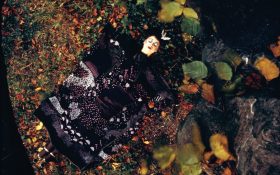Hand, Heart & Soul is at the City Art Centre. Showing many pieces never before on public exhibition, this is a glorification of the Scottish Arts & Crafts period and is full of yummy stuff.
I have to mention a few that stopped me in my tracks. Of the paintings, James Guthrie’s Midsummer (1892) from the RSA’s Diploma Collection, is simply wonderful. Soft greens, dappled shade, picnic on the lawn. Very Renoir. Lovely.
Lethaby’s elevations and plans for Melsetter in Hoy and Lorimer’s large format painted drawings for Formakin House are the stars amongst several sets of working drawings from different architects. I want them for my office.
There’s a fabulous dress in silk and velvet appliqué, with silk thread in satin stitch, by the gloriously named Daisy Agnes Anderson McGlashan. Dating from 1910, it employs the suffragette colours of green, violet and white. Maggie Hamilton’s embroidered panel from the same period is also extremely good and uses floss silk threads on a cream figured silk ground. The workmanship in this and in so many of the pieces in the exhibition is simply staggering. Margaret Gilmour’s repoussé brass ‘Peacock’ mirror is also a stand out. Then there’s the press cabinets by Lorimer and Macintosh, and the silver baptismal bowl, and…
The book that inspired the exhibition is for sale at £25 h/b and £17 p/b, but you can get them next day from Amazon at £16 and £11 respectively, so why would you do otherwise?
The Naked Portrait is showing at the Scottish National Portrait Gallery. It’s a curious exhibition and one which largely fails to do what it says on the tin:
“The Naked Portrait is a bold and innovative exhibition which sets out to explore the genre of naked portraits, looking at nearly 200 works from 1906 to 2006.”
It doesn’t explore the genre. It simply plonks images of naked bodies side by side in darkened rooms. Apart from the two Marilyn photographs, there are 198 matter-of-fact photos, paintings and drawings that mostly explore nothing whatsoever. I thought the best thing about it was the publicity. It might have come straight from the Fringe: Please note this show contains nudity. Children under 16 must be accompanied by an adult.
The biggest show in town is Andy Warhol at the RSA. He has always been a crowd pleaser, the difference today being that the crowds are getting bigger. What I found fascinating was a bit of people-watching as I moved through the gallery.
Having last seen a Warhol show in ‘89 at the Hayward, most of the images were familiar to me but I went to the Mound this time because his work is magnetic. Many others who coughed up their £8 to enter were obviously seeing this stuff for the first time and I saw what can only be described as almost universal delight written in their smiles. Warhol hits you in the face. It’s big, it’s bold, it’s colourful and essentially it’s graphic. Festival goers are discovering the power of Warhol for the first time and they like it. The shop is doing a brisk trade in facsimile art.
What’s new about this particular show is the inclusion of lots of his early graphic work from his advertsing days in the 1950s, including some exquisitely drawn shoes with witty captions. Also, downstairs, a film was playing. It was the one with Edie Sedgwick looking straight at the camera, occasionally blinking. Just that. Magnetic. His non-movie movies didn’t always work, notably Empire (1964), but that’s part of what you get with experimental artists.
I’ve got to say something about the galleries themselves. For a few weeks every winter the National Gallery exhibits their Turner watercolour collection, in the basement, behind screens in very low light, where they won’t come to any harm from UV. This is very understandable. Last time I saw them they were mostly faded anyway so the damage had been done before they came into the ownership of the National. What I can’t understand is why similar environmental conditions need apply to two of the three exhibitions that I viewed. At the City Art Centre, the top three floors were used for the Arts & Crafts exhibition and the lights were out on all three. The pieces are individually lit, but insufficiently to see much detail, and the movement space is left dark. It’s like a three dimensional maze with wall hangings. Strategically placed furniture blocks blind pathways. Some air conditioning machines were chugging away, but despite being a windy, coolish sort of day, the top three floors were humid and uncomfortable. This, despite windows being flung open and fans set up to help circulate the air.
The Scottish National Portrait Gallery is a dark, gloomy place. Very Victorian gothic. There’s a central light well but it doesn’t let much light in and none of this filters in to the hanging space of course. I’ve been on several previous occasions and found it disappointingly lacking in the essential qualities required for a gallery. This time it was overbearingly gloomy and there were, I think, no two hundred year old watercolours about to fade forever. In fact most exhibits in the show are photographic and some of those are hanging, not in frames but with bulldog clips gripping the photo surface itself. What’s going on here? It’s a dungeon of a place.
The Royal Scottish Academy, by way of contrast, is a very old building which feels surprisingly modern yet dignified and is considerably easier to navigate through than the other two. I don’t think the hanging committee got everything right, but they made a fist of it and, crucially, there is light where you want it and dark where it’s necessary. It’s almost as good a venue as the Scottish National Gallery of Modern Art.




